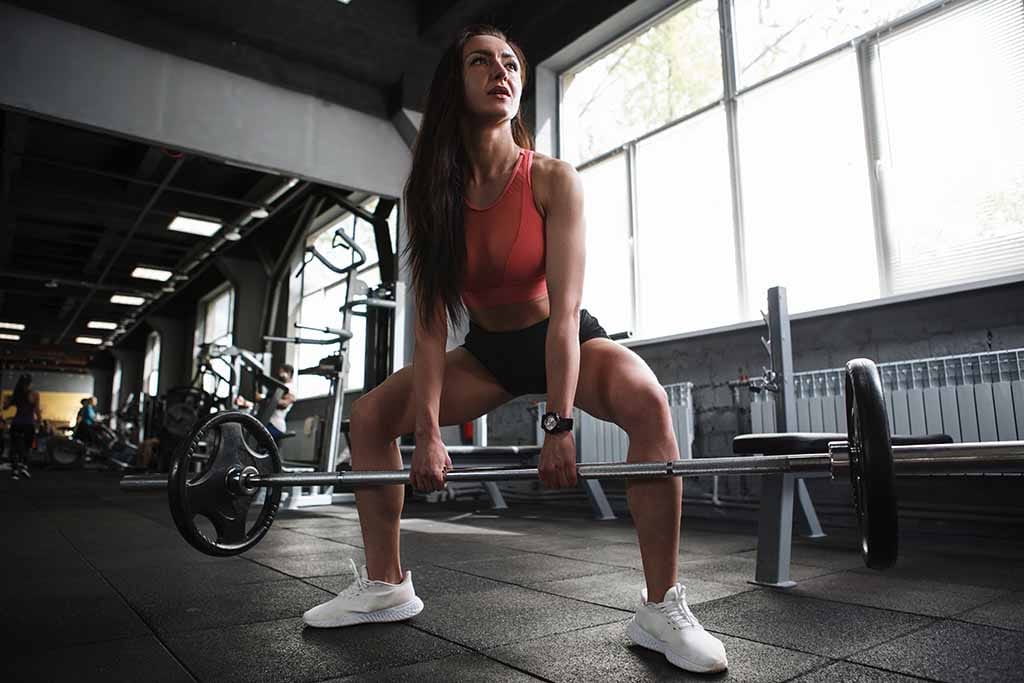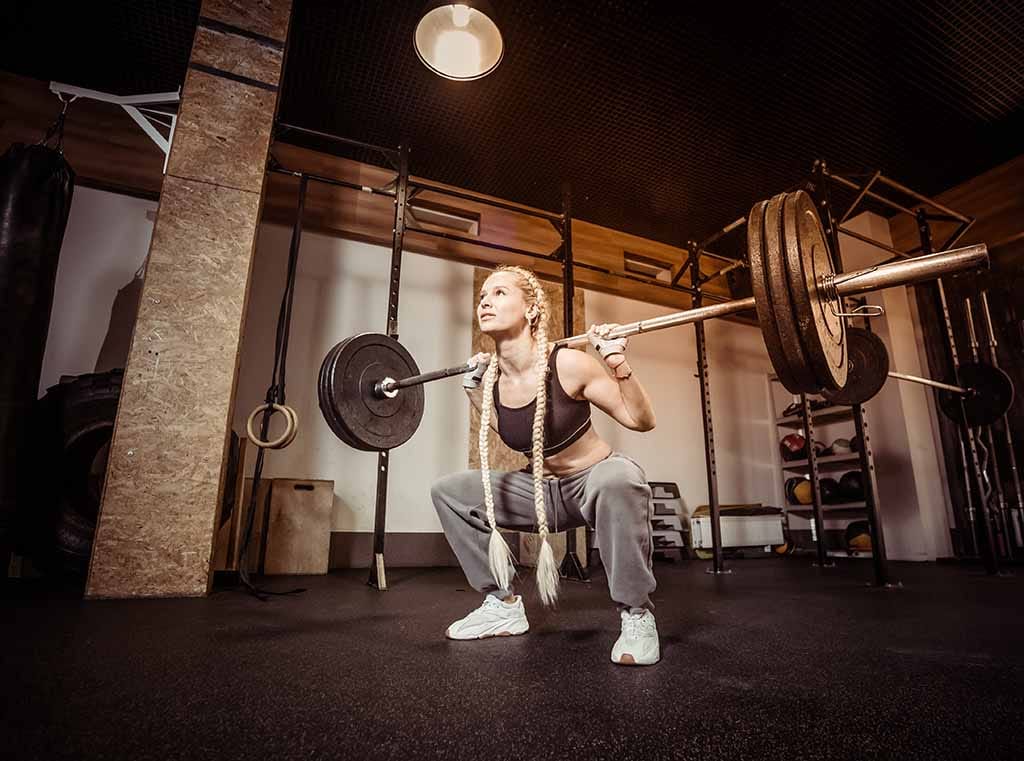Sumo Squat With Barbell: Attack Your Inner Thighs
If you want to take your squat game to the next level, the sumo stance can provide added emphasis on your inner thighs for some serious burning action (the good kind!). And what exercise can you do that combine squats and sumo stances? It’s the sumo squat with barbell.
In this article, we’ll explore the ins and outs of doing sumo squats with barbell. This squat variation targets the inner thigh muscles more effectively.
If you struggle with the look of unsightly body fat, building the muscles in your thighs while you slim down at the same time can be an effective aesthetic workout for building the lower half of your dreams.
Read on for a guide to sumo squats with barbells: we will cover how to perform this move with perfect form, the targeted muscles, and the key benefits.
Plus, get visual guides to help you ace your form and learn some essential safety precautions you should take before you sumo squat.
Keep reading to get the total guide.
What is Sumo Barbell Squat?
First, let’s get to understand what “sumo stance” really is in weightlifting terms.
In this exercise, your feet stay much wider than shoulder-width apart, with your toes pointed slightly outward. This aptly-named position puts you in a stance resembling a sumo wrestler's.
Using a wider foot placement shifts the emphasis to the inner thigh muscles (adductors) and engages the glutes and hamstrings more effectively, while still working the quadriceps and overall lower body.
We’ll go over the full guide to muscles worked in this move shortly, but first, let’s break down how you sumo squat with a barbell.
How to Perform Sumo Barbell Squats
Greg Gurenlian demonstrates sumo squats with a barbell, highlighting their benefits.
- Set-Up: Load a barbell with an appropriate weight.
- Body Position: Stand with your feet wider than shoulder-width apart and your toes pointed slightly outward. Place the barbell across your upper back, holding it with both your hands slightly wider than shoulder-width apart. Keep your chest up, shoulders back, and core engaged.
- Action: Hinge from your hips and knees to lower your body, pushing your hips back as if you were sitting into a chair. Keep your knees tracking over your toes. Lower your body until your thighs are at least parallel to the ground or slightly below. Keep your back and your spine neutral.
- Reverse: Drive out of your heels and straighten your hips and knees to come back to your starting position. That completes one rep.
- Reps: 3-4 sets of 8-12 reps.
Benefits of Sumo Squat With Barbell
You may wonder why you should try the Sumo barbell squat. Let’s see what benefits it has.

Inner Thigh Engagement
The wider stance of a sumo squat targets the adductor muscles more effectively. If you feel most of the burn in your inner thighs, you’re doing it right.
The open position of your knees, instead of having them point forward like in a barbell squat helps thigh engagement. Specifically, in a study on activation of gluteal, thigh, and lower back muscles in different squat variations, sumo foot placement has been shown to demonstrate more activation in two adductor muscles that have been researched: the vastus lateralis and the adductor longus.
If you want to trim down the look of flabby thighs, this can be a great move to tone up these muscles for better-looking legs. Although they won’t independently reduce body fat (you need to be in a calorie deficit to do this) stronger thigh muscles may make your legs look more toned from muscle size and definition.
Glute and Hamstring Activation
Greater emphasis on the posterior chain leads to stronger glutes and hamstrings. In general, the barbell back squat is considered one of the best compound glute exercises. Guess how effective the sumo barbell squat exercise can be.
Flexibility
This squat variation helps you increase your hip flexibility and mobility due to the wider stance and range of motion. If you suffer from hip pain when squatting, sumo squats can help you develop the muscles of your hips to alleviate soreness. They might hurt at first, but as you progress, you’ll likely start noticing more ease in your squats!
Incorporating sumo barbell squats into your workout routine can enhance lower body strength and muscle development while providing variety and targeting different muscle groups compared to traditional squats.
Barbell Sumo Squat— Muscles Worked
Now, let’s see what muscles are involved in sumo squat with barbell exercise:

1. Quadriceps (Quads)
Your quadriceps or “quads” extend your knee joint. In a sumo squat, the quads engage to straighten your legs as you rise from the “down” part of your squat.
2. Adductors (Inner Thighs)
These muscles adduct your inner thighs, meaning they bring your legs together toward the midline of your body. In your sumo squats, the wide stance heavily engages your adductors to help stabilize and control your descent and ascent.
4. Glutes
The glute muscles (your butt!) include your gluteus maximus, gluteus medius and gluteus minimus. These muscles extend and externally rotate your hips. The glutes are activated to extend your hips in a sumo squat as you push upwards, contributing to your overall lower body power and strength.
5. Hamstrings
Flex your knees and extend your hips. These muscles on the backs of your legs assist with hip extension when you come to standing during the upward phase of the squat.
6. Erector Spinae (Lower Back)
Squats can be a back exercise too! The erector spinae extend and stabilize your spine. These muscles keep your spine neutral during a sumo squat and give you stability as you move up and down.
Sumo squats also include activation from your:
- Core Muscles (Abdominals and Obliques)
- Hip Flexors:
- Calves
By engaging these muscles, sumo barbell squats offer a comprehensive lower-body workout that enhances strength, stability, and muscle development across multiple muscle groups.
Tips and Tricks— Sumo Squat With Barbell
It’s essential to master the basics, but once you feel comfortable in sumo stance and working with a barbell, there are a few hacks you can try to improve this move. For better barbell sumo squats:
1. Foot Grip and Angle Adjustment
- Spread the Floor: Focus on actively “spreading the floor” with your feet during the squat. No, we don’t mean literally unless you’re a magician!
This cue helps you engage your glutes and gives you a more stable base by activating your outer hips and legs.
- Adjust Your Toe Angle: Slightly tweak the angle of your toes so that they point outward at an angle of about 10-30 degrees. This lets you find the most comfortable and powerful position for your hip structure. Small changes in foot angle can enhance depth and stability.
- Torso and Hip Position: Allow your torso to lean very slightly forward so you keep your balance. This forward lean should come from your hips not your lower back, otherwise it could cause lower back pain when squatting. Although we want to remain upright during a squat, a very minor forward tilt is natural during barbell squats.
Other squat variations, specifically hack squat alternatives like the landmine hack squat, Smith machine hack squat or barbell hack squat are better squat exercises to work on if you want to stand completely upright. Because of your torso position, the hack squat technique puts more emphasis on your quads, compared to the sumo squat with barbell, where you want to work the glutes and adductors.
Safety Precautions for Sumo Squat With Barbell
Now onto a few quick safety drills!
Proper Form and Technique
Keep your feet wider than shoulder-width apart with toes pointed slightly outward. Your knees should track over your toes throughout the movement to prevent knee injuries. Keep your chest up, back straight, and core engaged to avoid rounding your back, which can lead to lower back injuries.
Controlled Movement
Perform the exercise with a slow and controlled tempo, especially during the lowering phase, to maintain balance and control. This helps prevent muscle strains and joint injuries. Lower yourself only to a depth where you can maintain proper form. Going too deep without proper flexibility can cause undue stress on the hips and knees.
Equipment
Start with lighter weights. Begin with a weight that you can comfortably handle while keeping proper form. Gradually increase the weight as you become more confident and stronger with your movement. When lifting heavy weights, use a squat rack with safety bars set at the right height.
You might want to consider also wearing a weightlifting belt to provide lower back support during heavy lifts. If you stick with these safety precautions, you’ll lower your injury risk and get a more effective and safe workout experience while you do barbell sumo squats.
Big Picture
Make like a sumo superstar and try sumo squat with barbell!
If you are serious about targeting your inner thighs, barbell sumo squats are a great alternative to barbell back squats.
They uniquely target your adductors glutes, and hamstrings because of the wider stance. This can improve your lower body strength and muscle development. If you struggle with stiff hips, like many of us, sumo squats are also a great way to improve hip flexibility and mobility
If you’ve got a desk job that’s hindering your mobility, this is one of the best squat variations you can use to counteract the negative effects on your mobility that crop up over time.
When you engage multiple muscle groups and stabilizers, you can also build a strong core and enhance your balance. Barbell sumo squats in your workouts can lead you to greater functional strength, better athletic performance, and a more balanced and powerful lower body.
Continue to crush your skull (not really!) and your workouts. Use Flex App to track your progresses as you do with plate tracking capabilities and auto progression. Try it out for free today.
Related articles


Get fit with Flex
Build muscle & lose weight fast for free.
Available on iPhone + Apple Watch





